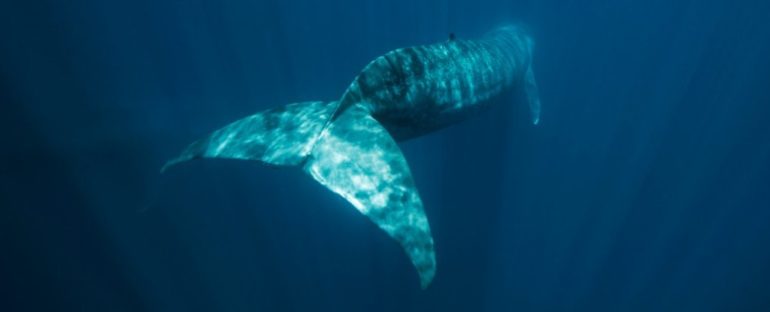Up to 1,000 shipping vessels storm through blue whale feeding grounds in northern Patagonia every day, according to a new study from researchers who say the findings should support an urgent conversation about the regulation of marine traffic in Chile.
The research, which used satellite tracking data to identify where blue whales – the largest mammal on Earth – come up against heavy shipping traffic, could also in time help to create strategies and safe havens to protect these ocean giants.
“This is a great example of where science can directly help inform conservation actions,” Vanessa Pirotta, a wildlife scientist at Macquarie University Australia, who was not involved in the study, told ScienceAlert.
“Studies like this are timely as our marine footprint continues to grow therefore, increasing the potential for interactions with these marine giants.”
Blue whales (Balaenoptera musculus), rare as they are, often surface unexpectedly from the depths to feed on krill close to the surface. It’s here they can be seriously wounded or worse, fatally injured by ship strikes.
Because the global shipping industry never sleeps, marine traffic is actually intensifying in many areas.
For blue whales, which only give birth every few years to offspring that take a decade to reach maturity, any fatal accident or harmful collisions represents a real threat to their conservation.
The more data scientists collect, the clearer the picture becomes. But of course, getting data on these mighty beasts that migrate across open oceans is challenging, let alone pinpointing when and where they encounter ships.
“In most countries, unreported cases, limited monitoring and insufficiently documented incidents have precluded any accurate assessment of the true collision prevalence,” wrote the study authors in their paper.
Identifying critical movement corridors, whale feeding and breeding grounds is a good place to start.
In this study, researchers from Chile, Argentina and the US focused on whales previously tagged in the Corcovado Gulf and Chileo Inner Sea, near Puerto Montt in northern Patagonia on Chile’s western coast, where some blue whales hang out in the warmer months.
These coastal waters, with an intricate array of inner passages, archipelagos, channels, and fjords, are regarded as the most important summer foraging and nursing ground for blue whales in the eastern South Pacific Ocean, a population which numbers only a couple hundred.
However, the region also hosts one of the largest salmon aquaculture industries in the world, with fleets of salmon farmers operating in the area alongside other industrial and artisanal fisheries, and marine transport routes.
To figure out where the ships and whales often cross paths, the researchers tracked blue whales as they moved through the gulfs, and charted shipping traffic patterns using data from Chile’s national fisheries and aquaculture service.
When you see the data animated for yourself, you can’t help but feel stressed for these whales zigzagging about to dodge heavy vessel traffic.
THREAD Are U stressed? Animation by @BedrinanaLuis shows 1 difficult week in the life of 1 #whale. BLUE DOT is 1 whale trying to feed while dodging heavy vessels traffic @ #Ancud Gulf 3/22/19 to 3/29/19 #shipstrikes #whales Paper @Nature https://t.co/EA2lt0F0l8 @alex_zerbini pic.twitter.com/XkQOeRXs4L
— Centro Ballena Azul (@ballenaschile) February 2, 2021
But this animation, tracking just one whale (the blue dot) for a week, shows only a “glimpse of the density of vessels whales are exposed to”, said lead author and marine biologist Luis Bedriñana‑Romano, who is based at the Austral University of Chile.
Altogether, the team tagged and tracked 15 blue whales, for between eight days and three months, that had to contend with hundreds, sometimes thousands, of ships a day.
Some whales went on brief excursions to deeper offshore (you can’t blame them) though most remained in the local area, sticking to places where they could happily feast on krill.
The researchers, considering all four types of marine vessels captured in the 10 months of available data, also showed that inner waters of the region had more shipping vessels with a higher chance of encountering whales than other areas.
Except one fleet stood out: the salmon farming industry represented a huge chunk of shipping activity in the area – up to 83 percent of vessels operating each day.
This means the industry “could play a decisive role” in reducing harmful interactions between boats and whales, Bedriñana‑Romano and his colleagues wrote.
“Combined research methods applied in this study using knowledge of whale behaviour and ecology, plus shipping movements is powerful for informing where interactions are likely to occur,” Pirotta told ScienceAlert.
“This also strengthens conservation approaches and efforts to help minimise future interactions.”
Strategies to prevent ships strikes have been effective in the past. The aptly named Ship Strike Rule, for example, introduced in 2008 to re-rout shipping traffic around seasonal habitats of North Atlantic right whales, reduced fatalities in protected areas.
Introducing speed regulations to slow down ships in whale-filled waters could be another option.
But of course, It’s not just physical injuries from ship strikes that endanger whales. Noise pollution in heavily trafficked shipping areas can also be potentially harmful to marine life that use sound to communicate.
“Acoustic pollution from ships reduce[s] the available space for whales to talk to each other,” Pirotta said in an email.
“Blue whales use low-frequency sounds that are capable of travelling many kilometres.”
Another way forward is for researchers to study blue whale behaviour in close proximity to ships, but already this study sounds a clear message.
“The results of this study clearly pinpoint specific areas where management actions are urgently needed, especially considering the undetermined number of vessel strikes and levels of noise exposure in the region,” the authors concluded.
The research was published in Scientific Reports.



